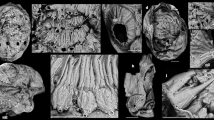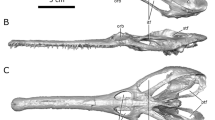Abstract
Advanced fossil and living rotaliacean foraminifera are characterized by canal systems located within the walls of their plurilocular calcareous tests. Although these canals were described in detail during the nineteenth century1–4, their biological functions have remained obscure. A study of the Recent nummulitid, Heterostegina depressa, has now illuminated the role of the canal system and allowed us to interpret similar structures seen in related foraminifera of Tertiary age. It proves to be a structure of fundamental importance for locomotion, growth, excretion, reproduction and protection.
This is a preview of subscription content, access via your institution
Access options
Subscribe to this journal
Receive 51 print issues and online access
$199.00 per year
only $3.90 per issue
Buy this article
- Purchase on Springer Link
- Instant access to full article PDF
Prices may be subject to local taxes which are calculated during checkout
Similar content being viewed by others
References
Carpenter, W. B. Q. Jl geol. Soc. Lond. 6, 21–39 (1850).
Carpenter, W. B. Phil. Trans. R. Soc. 149, 1–41 (1859).
Carter, H. J. Ann. Mag. nat. Hist. Ser. 2, Vol. 10, 161–176 (1852).
Carpenter, W. B., Parker, W. K. & Jones, T. R. Introduction to the Study of the Foraminifera, 1–319 (Hardwicke, London, 1862).
Haynes, J. R. Foraminifera 1–433 (Macmillan, London, 1981).
Lipps, J. H. in Biotic Interactions in Recent and Fossil Benthic Communities (eds Tevesz, M. J. S. & McCall, P. L.) 331–376 (Plenum, New York, 1983).
Haynes, J. R. Contr. Cushman Fdn Foram. Res. 16, 40–43 (1965).
Ross, C. A. Proc. 2nd int. Coral Reef Symp. 1, 327–333 (Great Barrier Reef Committee, Brisbane, 1974).
Hottinger, L. in Foraminifera Vol. 3 (eds Hedley, R. H. & Adams, C. G.) 203–266 (Academic, London, 1978).
Röttger, R. Mar. Biol. 15, 150–159 (1972).
Hottinger, L. Mem. Mus. Natn. Hist. nat. Paris nouv. sér. C, 40, 3–159 (1977).
Spindler, M. & Röttger, R. Mar. Biol. 18, 146–159 (1973).
Spindler, M. J. Foram. Res. 8, 319–333 (1978).
Billman, H., Hottinger, L. & Oesterle, H. Schweiz. Palaeont. Abh. 101, 71–113; 1–39 (1980).
Röttger, R. & Inst. Wiss. Film, Film C 1451 des IWF, Göttingen (1982); Publ. Wiss. Film., Sekt. Biol., Ser. 15, No. 21, 1–15 (1982).
Schmaljohann, R. thesis, Univ. Kiel (1980).
Röttger, R. & Inst. Wiss. Film, Film C 1506 des IWF, Göttingen (1983); Publ. Wiss. Film., Sekt. Biol. (in the press).
Schmaljohann, R. & Röttger, R. J. mar. Biol. Ass. U.K. 58, 227–237 (1978).
Röttger, R. Mar. Biol. 21, 127–138 (1973).
Röttger, R. & Richwien, M. Abstr. 5th int. Congr. Protozool., New York (1977).
Author information
Authors and Affiliations
Rights and permissions
About this article
Cite this article
Röttger, R., Spindler, M., Schmaljohann, R. et al. Functions of the canal system in the rotaliid foraminifer, Heterostegina depressa. Nature 309, 789–791 (1984). https://doi.org/10.1038/309789a0
Received:
Accepted:
Issue Date:
DOI: https://doi.org/10.1038/309789a0
This article is cited by
-
Growth, chamber building rate and reproduction time of Palaeonummulites venosus (Foraminifera) under natural conditions
Coral Reefs (2017)
-
Calcified structures and calcification in protists
Protoplasma (1994)
-
Observations on the biology of Calcarinidae (Foraminiferida)
Marine Biology (1990)
-
The size and function of the internal inorganic carbon pool of the foraminifer Amphistegina lobifera
Marine Biology (1988)
-
Marine fungi (Ascomycetes) within and on tests of Foraminifera
Marine Biology (1985)
Comments
By submitting a comment you agree to abide by our Terms and Community Guidelines. If you find something abusive or that does not comply with our terms or guidelines please flag it as inappropriate.



